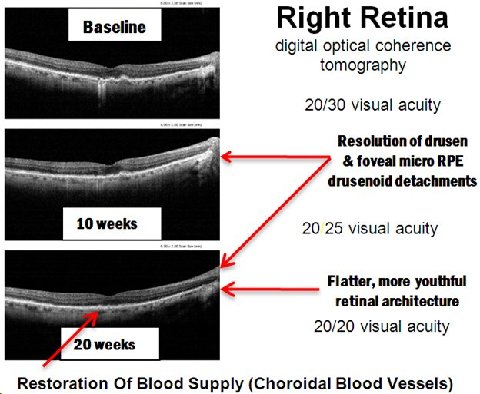ResveratrolConsumer
avert online
consumer fraud
ResveratrolQuiz
test your knowledge
New E-Book
How the world got lost on
the road to an anti-aging pill
Subscribe to our newsletter to receive email notifications when new articles are posted.
December 31, 2012: by ResveratrolNews
North Chicago, IL (December 31, 2012) – The first report using molecular medicine to regenerate damaged tissues in the back of the human eye via use of small antioxidant molecules to promote survival of internally-produced stem cells is being reported today. It may be the first successful report of cellular or tissue regeneration via internally-derived stem cells in all of medicine.
In a newly published scientific book (Advancing Medicine With Food & Nutrients, 2nd edition, CRC Press (Ingrid Kohlstadt, editor), Dec 2012), Dr. Stuart Richer, OD, PhD, Director, Ocular Preventive Medicine- Eye Clinic at the James A Lovell Federal (Veterans) Health Care Center in North Chicago, presents striking photographic evidence of stem cell regeneration of damaged tissues at the back of the eye of a patient with dry macular degeneration accompanied by restoration of vision after using a nutriceutical comprised of small natural antioxidant molecules.
Dry macular degeneration is a leading cause of blindness among senior Americans and is called “dry” because there is no swelling due to accumulation of blood serum at the back of the eyes as there is in “wet” macular degeneration. Currently there is no effective treatment for the dry form of this disease. In both forms of this disease, central vision used for reading and driving is destroyed.
A report published as recently as June of 2012 said, in regard to recruiting internally-derived stem cells for repair and regeneration, that the state of the science “isn’t there yet,” meaning it’s not ready for delivery to patients. The report said the “identification of appropriate molecules” to promote survival of internally produced stem cells is also “not there yet, but we are getting close.”
Researchers recently said: “if we could somehow recruit endogenous (internal) stem cells then perhaps we could enhance tissue repair and regeneration.”
For most of the past century it was mistakenly believed stem cells existed only for a brief time during early development and needed to be obtained from human embryos. The use of internally-produced stem cells obviates the need to harvest stem cells from other sources or even the patient’s own tissues for re-injection.
Attempts to transplant retinal cells in humans have been met with difficulty. In one study the rejection rate was 75% without immune-suppressing drugs being used. In animals, even though implanted retinal cells were not immediately rejected, chronic low-grade rejection occurred. Scarring, immune rejection, or malignancy emanating from use of immune-suppressant drugs, are drawbacks to retinal transplantation, says Dr. Richer.
An alternative to re-injection of stem cells obtained from the patient’s own tissues and grown in a lab dish is to employ methods that would promote survival of internally generated stem cells after tissue injury. The possibility of using molecular medicine to elicit retinal repair via endogenous stem cells would obviously be safer, easier and more efficient and economical than implantation of cells.
Dr. Richer says it is well known that stem cells have the potential to replace damaged light-receptor cells in the back of the eyes. Stem cells are unspecialized cells capable of self-renewal through cell division and under certain conditions can be induced to become heart, brain, muscle, eye, etc. cells with specialized functions.
The use of small molecules that can penetrate the protective retinal barrier facilitated the survival of endogenous (internal) stem cells and resulted in regeneration of cells that are generally believed to irreversibly die off with subsequent loss of vision.
Stem cells from human embryos don’t need to be implanted as many adult tissues contain populations of stem cells that are generated when tissue damage occurs.
“While we do not have direct photographic confirmation, we believe this regeneration of retinal tissue was induced by stem cells. There is no other plausible explanation,” says Dr. Richer.
The antioxidant cocktail employed by Dr. Richer was a carefully selected nutriceutical (Longevinex®) known for its high quality (micron-sized and micro-encapsulated active ingredients), superior performance, broad gene activation, absence of toxicity and prior successful use in humans. ####
Contact Information:
The first Stuart Richer, OD, PhD, FAAO Director, Ocular Preventive Medicine- Eye Clinic James A Lovell Federal Health Care Center –
North Chicago 3001 Green Bay Road, North Chicago, IL 60064-3095
Associate Professor, Family & Preventive Medicine Rosalind Franklin University of Medicine & Science – North Chicago Assistant Clinical Professor, UIC Dept. of Ophthalmology and Visual Science – Chicago

Digital images of the right-eye retina of an 88-year old male with dry macular degeneration in his right eye are presented. The patient was able to retain his license to drive an automobile.
Posted in Resveratrol
Add comments »